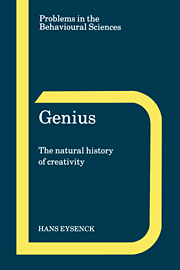Book contents
- Frontmatter
- Contents
- Introduction
- 1 The nature of genius
- 2 Genius and intelligence
- 3 Creativity: measurement and personality correlates
- 4 Conditions for excellence
- 5 Intuition and the unconscious
- 6 The nature of psychopathology: psychoticism
- 7 The roots of creative genius
- 8 From DNA to creativity and genius
- References
- Index
5 - Intuition and the unconscious
Published online by Cambridge University Press: 04 August 2010
- Frontmatter
- Contents
- Introduction
- 1 The nature of genius
- 2 Genius and intelligence
- 3 Creativity: measurement and personality correlates
- 4 Conditions for excellence
- 5 Intuition and the unconscious
- 6 The nature of psychopathology: psychoticism
- 7 The roots of creative genius
- 8 From DNA to creativity and genius
- References
- Index
Summary
Thou shalt not muzzle the ox that treadeth the corn
BibleStages of problem-solving
Two notions, ideas, concepts – call them what you like – have always been attached to the problem of creativity. Is has been widely surmised that the creative genius generates his major ideas by way of intuition, rather than rational thinking; reason can test and prove or disprove the insights achieved by intuition, but cannot produce them. Furthermore, the process by means of which intuition works is unconscious; the Unconscious, whether with or without a capital ‘U\ is the cradle of creativity. I will spell out some of the data on which this commonsense view rests (mainly anecdotal), and then go on to define the concepts experimentally.
Many famous scientists have identified stages of problem-solving; these nearly always include a central stage during which unconscious cerebration, mentation, or whatever predominates. Thus Helmholtz (1896) postulated an initial investigatory stage, during which he became saturated with the large body of relevant facts. This was followed by a stage of rest and recovery, during which he gave no conscious attention to the problem, and finally a stage of illumination, when he had sudden insight into the solution – the ‘aha!’ experience. Similarly descriptions are given by Dewey (1910), Rossman (1931), Osborn (1953), Johnson (1955), Cattell (1971), and Mansfield and Busse (1981). Wallas (1926) put various introspective accounts together in his frequently cited four-stage scheme: (1) Preparation; (2) Incubation; (3) Illumination; and (4) Verification. To these has recently been added a stage of Problem-finding, which precedes Wallas's stage one (Arlin, 1975; Bunge, 1967; Dillon, 1982; Chand and Runco, 1993).
- Type
- Chapter
- Information
- GeniusThe Natural History of Creativity, pp. 170 - 201Publisher: Cambridge University PressPrint publication year: 1995

